Columnist Paul Ford discusses what marketers should bear in mind in order to deliver the best email experience and strengthen engagement.

With Web-based communications infiltrating all aspects of life, email has become one of the best ways for businesses to communicate with their users. Knowing how to best communicate and market goods and services to customers via email is key to business success and expansion.
No matter what type of marketing email you’re sending — whether it be newsletters, promotions, coupons and special offers, or transactional email such as purchase receipts, notifications, or order confirmations — the scattergun approach is no longer the right way to go about communicating with your users. To maximize response and delivery, you cannot treat all of your users the same way.
You can realize exponential ROI benefits by segmenting your email so that each one is relevant and valuable to your customers. The trick is to use your available data to fine-tune your messages and deliver communications that will motivate your user to take action.
Listed below are the most important things to bear in mind when aiming to maximize your data and increase engagement across your email communications.
1. Customer Activity
It’s always important to determine the activity of your customers and to develop strategies that target them. See some suggestions below:
The frequent buyer/user
Identify which customers have made three or more purchases from your site in the past three months, or those who have spent over a certain amount. If you don’t have recurring sales, send them a special promotion to “reward” their activity and encourage them to share the information or offer.
Take the example of Klout (Disclosure: client), which rewards its highest influencers with perks. Frequent buyers and users are the evangelists of your brand, and you should treat them with high regard.
The new buyer
Here you have the opportunity to turn newbies into frequent purchasers. Focus your email communications on extending the relationship, and use their interests or purchase behavior to deliver custom communications.
If they bought size 10 shoes, send them an email with other shoes they might like in their size. If you sell software, send usage notifications or alerts via email to keep them connected to your platform.
Your goal is to continuously drive value, especially if you provide monthly plans.
Free trial subscriber
If you offer a free trial, then you must immediately show value in order to convert your trial customer into a paid one. Focus your messages on getting your user started and invested in your service.
Provide tutorials or helpful tips to get users motivated. During the free trial, communication should be frequent and always helpful.
Inactives
Don’t ignore the people who aren’t interacting with your brand. They were interested once, so determine what’s going on.
Identify any common factors. Do you offer something different from what you offered before? Are they on a free plan with limited features? Have their needs changed? Isolate the users who might still be a good fit, and deploy a win-back program.
As a best practice, remove anyone who has not responded to your email campaigns in the last six months. In the end, it’s better to have a smaller, more active list than to have a larger one littered with non-responders.
Non-converters
If you offer a free trial, and your user fails to convert to a paying customer, don’t give up. Ask why, so you can gather important information on how to improve your conversion process.
Then, periodically send users special offers or product highlights for a set period of time to win them back. Join.me is a good example — it sends limited-time incentives, but also product updates inviting the user to start another free trial.
2. Demographics And Behavior
Create comprehensive buyer profiles to develop your email segmentation strategy. Start with the basics around demographics, and then work your way up to behavioral data to optimize your email for maximum response.
Location
Location-based offers are effective, particularly for brick-and-mortar brands or applications that utilize location to power engagement with their platform.
If you ask for their address, then use it. Local stores may want to collect ZIP codes; B2B companies may need states; global organizations will want country.
Gender/age
Does your offering appeal to an older segment of the population? Do you target newlywed couples, or do you focus on parents? This information will be invaluable when structuring your communications and in understanding attrition going forward.
For instance, newlyweds won’t be newlyweds forever. Your messages will have to grow with them if your goal is to keep them as lifelong customers.
Occupation
Even if your product appeals to similar audiences, they all have different agendas, depending on their industry. For instance, your Web application may appeal to both marketers and developers.
However, you’ll need to adapt your messages to their respective pain points in order to drive interest. These differences are further highlighted by position — a CIO has different goals from those of an engineer, and you should talk to them accordingly.
Last purchase
Use online behavior to drive your next communication. Offer a product to complement what customers just bought, or use their online activity to identify which of your website pages held their attention.
Analyze click-through data to evaluate email effectiveness. What did they click on, and why did they convert?
Average order value
Identify your high-value customers, and tailor to that segment. Offer more attractive incentives to your most valuable customers to retain their business and achieve deeper engagement with these customers. For example, Zappos’ VIP program offers free next-day shipping to members.
3. Email Stream Type
Consider the type of email stream. With increased relevancy comes increased response and therefore, higher deliverability. While dedicated IP addresses are not free, they are the key to your reputation, so invest accordingly.
Marketing vs. transactional
Marketing email tends to have higher delivery failures, since it is most often labeled as spam or goes unread, unopened or treated as “junk mail” by recipients.
Because transactional email has higher open rates, a best practice is to send your transactional messages on a separate IP. This way you can better monitor, troubleshoot, and track delivery success rates (and failures) by your major email streams.
Email type
You can further segment your email streams into the types of email sent. For instance, order cancellations that are initiated by a customer may receive separate treatment and follow-up than an order cancellation that is initiated by the company.
Keep in mind that customer support emails may be one of your most critical messages in terms of delivery. It may be a good idea to isolate these messages to ensure they reach your users.
No matter what type of email you send, you should always follow the best practices to make sure your emails get delivered. Now that ISPs are actively monitoring engagement to determine delivery, email optimization has become imperative, and it all starts with segmentation. By segmenting your email by activity, demographics, behavior, and email stream and type, you can create interesting dialogues that will deepen your relationship with your users.
Moreover, you should monitor your email delivery and response rates with every deployment. This data can help you prevent delivery failures from negatively impacting your email program and provide important clues as to how recipients are responding to your messages.
Your end goal should be to deliver the best possible email experience. That means focusing on the customer and, wherever possible, customizing your emails to speak directly to your users.
Some opinions expressed in this article may be those of a guest author and not necessarily Marketing Land. Staff authors are listed here.
(Some images used under license from Shutterstock.com.)
Marketing Land – Internet Marketing News, Strategies & Tips
(200)










